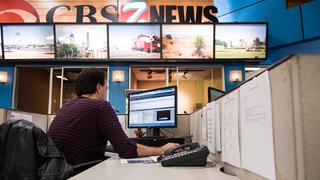Content: From News to Sports and Beyond
NEW YORK—Content production and monetization has evolved as viewers are presented with more and more programming options delivered to multiple devices. The Content FWD sessions on Inspiration Stage 2 at NAB Show New York will address the production of news, sports and VR content, among others.

One important part of a newsroom's success is its staff. The challenge for many general managers is finding competent, diverse talent. In Wednesday's session “Tapping Diverse Talent, reaching Diverse Communities: A Plan that's Working!,” panelists Marian Pittman and Jessica Sooknanan, both of Cox Media Group, will discuss the company's Digital Talent Program and introduce one of its rising star graduates. The session is moderated by Marcellus Alexander of the National Association of Broadcasters.
Sports—live linear content, clips, highlights and slow-motion capture—remain an essential component of the content world. In the Thursday session “The New York Jets: Technology's Role in Modern Sports Production,” New York Jets Vice President and Executive Producer Chris Gargano talks to Avid's Vice President of Market Solutions Alan Hoff, about the role technology plays in producing and managing content to engage fans across multiple platforms.
Gargano oversees Jets' content, which includes video production, social media and editorial. He will share a behind-the-scenes look at the team's content production, highlighting the importance of connecting production teams so that everyone can access the same media and metadata, and create content from anywhere. He also said technology needs to be in lockstep with the people who operate it.
“In today's complex media world, content producers have to be organized, and not with just workflows, but in their collective mindsets,” said Gargano. “Rapidly evolving technology has altered the paradigm of production and we all have to keep up in this ever-changing landscape. The goal of this talk will be about collectively getting to the core of multiplatform content production.”
Another Thursday session, “Journalism in the Age of 'Fake News,'” is produced in partnership with Radio & Television Digital News Association (RTDNA).
Dan Shelley, executive director of the RTDNA, said the modern rebirth of the term “fake news” dates to the early days of the 2016 presidential election cycle.
“Real 'fake news' is false information published intentionally to mislead the public,” said Shelley. “In today's unfortunate political and ideological vernacular, it means news that a person or people label as 'fake' is most likely factual information they don't like, don't agree with or find inconvenient within the context of their agenda.”
One aspect of the problem is that too many people stay within their comfort zones, said Shelley, seeking information only from sources that reinforce their existing beliefs. Another is that too many people conflate the opinion media—talk radio, certain primetime cable shows, etc.—with responsible journalism.
He added that while the explosion of new and different sources of information has had the same effect as a strong breeze during a wildfire, the large number of outlets has also provided the public with more opportunities to check the veracity of information they receive.
Another point to the issue likely to be discussed is the obstruction, harassment, threats, arrests and assaults journalists face when trying to do their job, said Shelley.
In the session “Diversity in VR Storytelling: A Look at A Little Love,” filmmaker Alton Glass takes us inside his virtual reality film “A Little Love.” At a time when there are no gatekeepers and keymasters in the uncharted landscape of VR, he'll take a deep dive into using new tools and resources to tell diverse stories, in front of and behind the camera.
Other sessions include discussion of the virtualized, remote future of live production, a look at digital age hybrid studios and advances in ad-supported streaming services.
Get the TV Tech Newsletter
The professional video industry's #1 source for news, trends and product and tech information. Sign up below.

